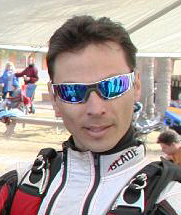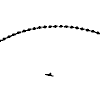Remember the KISS concept----Keep it simple "something"...
Give each flyer two small paint gun pistols one in each hand and pointing outward at 90 degrees from the grippers. Each pistol will be adjusted to have only and "exactly" just a certain range desired... and the colors will vary depending on assigned slot in the formation. Then at a predetermined ditter altitude , eveyone fires their pistol at the flyer to each side. Then you land ,..and do an after jump lay-on-the -ground dirt-dive to see just where the different colors hit the participants. ... Simple and Fun!!! Have Tony fund the pistols since he will wind up selling many more replacement wingsuits.
I also want to invite all of you to the Stoney first annual wingsuit rodeo jousting tournament to be held wherever I can find a DZ outside the USA that will aloow us to conduct the event... Should we use "official" solid foam "stickers" or allow things like heavy rubber chickens to be thrown in the "open" expert category... I am a GO on this idea !..... does anyone seriously doubt that?
Give each flyer two small paint gun pistols one in each hand and pointing outward at 90 degrees from the grippers. Each pistol will be adjusted to have only and "exactly" just a certain range desired... and the colors will vary depending on assigned slot in the formation. Then at a predetermined ditter altitude , eveyone fires their pistol at the flyer to each side. Then you land ,..and do an after jump lay-on-the -ground dirt-dive to see just where the different colors hit the participants. ... Simple and Fun!!! Have Tony fund the pistols since he will wind up selling many more replacement wingsuits.
I also want to invite all of you to the Stoney first annual wingsuit rodeo jousting tournament to be held wherever I can find a DZ outside the USA that will aloow us to conduct the event... Should we use "official" solid foam "stickers" or allow things like heavy rubber chickens to be thrown in the "open" expert category... I am a GO on this idea !..... does anyone seriously doubt that?
Life is what happens while we are making other plans.
lurch 0
Yo Rick!
hen again, if you are only flying solos, then about all you have to "play with" are the numbers (right, Lurch???
Damn right. Numbers are important to me for technical reasons, performance measuring, ninja tricks and suit hacks. Flocking, its all relative. One mans dirty flying is another man's maxed out. Flocks, its all about hanging out with friends up in the sky.
Anyway heres a thought... I'm not sure if its more about judging it or a method for making a real gridperfect flock...
Brian Snarr and I got to talking about this at the event. He'd mentioned using lasers in a way that I thought wouldn't work, can't remember exactly what he said but figured maybe hes onto something there, and started imagining a setup done with off-the-shelf industrial laser counter/emitter/pickup modules.
Problem is the expense. When I thought about it for a bit I realized you could actually automate flock building and alignment. 45 degree lines off the lead bird, low intensity visible/IR, wide beam divergence meaning the line is a beam a foot wide at the far end of the formation with about a 5 foot wide fringe to the beam. Each jumper has a pickup module with output coupled to audio producing a tone varying in intensity by signal strength. We use this stuff routinely in industrial automation for object presence detection.
Jumpers either have beam repeaters on their tails/rigs to deal with beam obstructions, tune it so it deals with a large black area in the center of the beam and temporary total beam obstruction or you could go for REAL brutal accuracy, use two beams and keep all birds between the beams by that audio feedback. You get near your slot, you get tone. Get closer to perfectly aligned, tone gets louder? Higher? Lower? Faster. Whatever. You're probably looking at sticking a laser reflector return decal on each jumper to make it easy for the modules to see the jumpers buts thats trivial.
Totally doable actually but insanely expensive, several thousand dollars per bird minimum to pull it off. The modules themselves are 3-700$ each, the logic to make use of their output and make a "flock gps" protracklike gadget out of it would triple that or more, easily. Might be able to pull a few shortcuts with consumer bluetooth gear though, get these things to talk to a headset through a phone or even an Ipod or something.
The same tech can be used in a different way for true proximity/location sensing and feedback if all birds have 4 emitters and pickups on all sides getting yes/no/how close feedback either by audio or a simple line of LEDs across the bottom of the goggles would suffice. One of the modules I have in mind already has both a scaled numeric and bargraph display right on it, you could just bolt it to a fullface helmet.
But come on... do we really want to automate this? The expense required to pull off such an insanely complex effect would not match the return in effort needed to do it. We get robotic enough with it people will mistake us for RW guys or something. Couldn't we just sort of do it the old fashioned way, by, you know, improving our skills and stuff?
-B
hen again, if you are only flying solos, then about all you have to "play with" are the numbers (right, Lurch???
Damn right. Numbers are important to me for technical reasons, performance measuring, ninja tricks and suit hacks. Flocking, its all relative. One mans dirty flying is another man's maxed out. Flocks, its all about hanging out with friends up in the sky.
Anyway heres a thought... I'm not sure if its more about judging it or a method for making a real gridperfect flock...
Brian Snarr and I got to talking about this at the event. He'd mentioned using lasers in a way that I thought wouldn't work, can't remember exactly what he said but figured maybe hes onto something there, and started imagining a setup done with off-the-shelf industrial laser counter/emitter/pickup modules.
Problem is the expense. When I thought about it for a bit I realized you could actually automate flock building and alignment. 45 degree lines off the lead bird, low intensity visible/IR, wide beam divergence meaning the line is a beam a foot wide at the far end of the formation with about a 5 foot wide fringe to the beam. Each jumper has a pickup module with output coupled to audio producing a tone varying in intensity by signal strength. We use this stuff routinely in industrial automation for object presence detection.
Jumpers either have beam repeaters on their tails/rigs to deal with beam obstructions, tune it so it deals with a large black area in the center of the beam and temporary total beam obstruction or you could go for REAL brutal accuracy, use two beams and keep all birds between the beams by that audio feedback. You get near your slot, you get tone. Get closer to perfectly aligned, tone gets louder? Higher? Lower? Faster. Whatever. You're probably looking at sticking a laser reflector return decal on each jumper to make it easy for the modules to see the jumpers buts thats trivial.
Totally doable actually but insanely expensive, several thousand dollars per bird minimum to pull it off. The modules themselves are 3-700$ each, the logic to make use of their output and make a "flock gps" protracklike gadget out of it would triple that or more, easily. Might be able to pull a few shortcuts with consumer bluetooth gear though, get these things to talk to a headset through a phone or even an Ipod or something.
The same tech can be used in a different way for true proximity/location sensing and feedback if all birds have 4 emitters and pickups on all sides getting yes/no/how close feedback either by audio or a simple line of LEDs across the bottom of the goggles would suffice. One of the modules I have in mind already has both a scaled numeric and bargraph display right on it, you could just bolt it to a fullface helmet.
But come on... do we really want to automate this? The expense required to pull off such an insanely complex effect would not match the return in effort needed to do it. We get robotic enough with it people will mistake us for RW guys or something. Couldn't we just sort of do it the old fashioned way, by, you know, improving our skills and stuff?
-B
Live and learn... or die, and teach by example.
dzjnky 0
Interesting stuff, Lurch - figured you would build some industrial strength solution for us ![]() ... but all the technology in the world won't help us if we can't decide what constitutes a perfect formation... I guess that can change from event to event, but to compare various formations in an attempt to create "official" records, we need a consistent judging criteria so there isn't any second guessing on whether "we got it" or not. So, while the technology is the fun part (for me, Lurch, and numerous others too!) we still need more discussion on what constitutes a "record-worthy flock".
... but all the technology in the world won't help us if we can't decide what constitutes a perfect formation... I guess that can change from event to event, but to compare various formations in an attempt to create "official" records, we need a consistent judging criteria so there isn't any second guessing on whether "we got it" or not. So, while the technology is the fun part (for me, Lurch, and numerous others too!) we still need more discussion on what constitutes a "record-worthy flock".
lurch 0
Well I can see a true "record" flock being one in which Mike didn't geek the camera, not even once, but he's GOT to geek it at least once for it to feel complete. I still have him on tape in what has got to be the longest camera geek EVER... I was like what the fuck, we're having a blast here, and just kept the cam on him. 37 seconds after exit he was still geekin' when we finally had to make the first turn and break the geeklock. I was like "Man. Doesn't your tongue dry out something wicked like that?"
Mike, you gotta get up here again ASAP n come freeze your ass off with us bro. We missya.
-B
Mike, you gotta get up here again ASAP n come freeze your ass off with us bro. We missya.
-B
Live and learn... or die, and teach by example.
fasted3 0
I think a slot perfect formation would not have to fit into a grid pattern as long as everybody was in the right place. Look at big formations of birds - their V will ripple with the wind, but they stay slot perfect. We should allow for this in our definition of the record or perfect flock. One pic of the 71 formation that I've seen would meet the criteria on one side, IMO, even though it was well off the grid. In any case, seeing the magnificent sight of so many flying so well, a record was achieved anyway. We may want to move the goal posts as we progress, but what a huge step forward our discipline has taken. Well done to all involved!
But what do I know?
mccordia 73
I think we're all pussies, and we just need to learn to fly this sucker docked![]()
JC
FlyLikeBrick
I'm an Athlete?
FlyLikeBrick
I'm an Athlete?







Oh come on you love it just a little don't you?
Probably about as much as a guy with a flat tire enjoys using a jack. The rest of the time, not so much.
Some people dream about flying, I live my dream
SKYMONKEY PUBLISHING